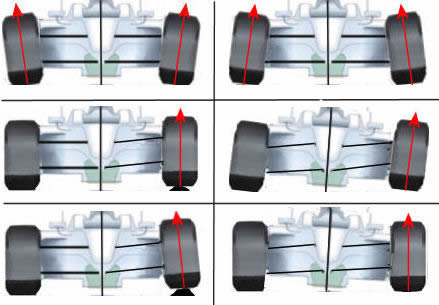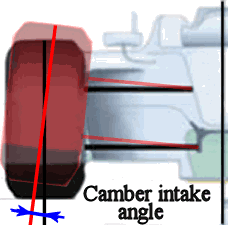Camber
Camber is the angle of the wheels in relation to the ground if you look from the front of the car. The tire's relationship with the road changes as the suspension moves through its travel.
Ideally, you want a camber curve that keeps the tire straight up and down when you are driving straight, and leans the tire in slightly (1 to 2 degrees of negative camber) during cornering.

So, a neutral camber will be |-| (while looking at the car from the front),
A Negative Camber will be /-\ ,
And a Positive camber will be \-/ .
(TOP LEFT) Positive camber: The bottoms of the wheels are closer together than the tops.
(TOP RIGHT) Negative camber: The tops of the wheels are closer together than the bottoms.
(CENTER) When a suspension does not gain camber during deflection, this causes a severe positive camber condition when the car leans during cornering. This can cause funky handling.
(BOTTOM) Fight the funk: A suspension that gains camber during deflection will compensate for body roll. Tuning dynamic camber angles is one of the black arts of suspension tuning.
Negative camber allows the weight of the car lean on the outer, more loaded tires, providing additional contact in a corner. However, on level ground and straights, the more camber you have the less contact surface area the tire has to the road.
While it is true that a car's suspension will most likely pass through various degrees of all of them in the normal operation of the vehicle (depending on set up and design), having a good base in the beginning will be vital in having a competitive package for a given goal.
A negative camber in the front tires is always recommended, and in most situations the front camber value should be higher than the rear. By having little camber on the rear ityres, grip is consistent for right and left corners despite the inside front tire picking up off the ground a little (in extreme cases). Rear camber should be as
close to Zero or neutral as much as possible, providing as much contact pach and grip to the rear as possible. Unless you are tuning to reduce oversteer, then a little negative camber is OK.
On oval tracks (US type of racing), the inner wheels will need positive camber and the outer wheels will need negative camber to counter the angle of the track (if you remember, it was a lot of talk about that before first US GP in Indianapolis because of last, banked corner).
Using camber to reduce oversteer and understeer should be treated as a secondary option to adjusting springs and shocks or wings first. Unless you are intentionally tuning for a drift car. Using more camber than necessary is not advisable and will result in reduced grip on flat straights and increase tire overheating and wear. Tire is overheated in contact area, and to cold in the rest of tire surface. This situation can cause a blistering of the tires.
There are some key disadvantages of camber angle, though. The teams optimise the aerodynamics of the car around a specific camber angle in the wind tunnel and on CFD design software. Adjusting the camber too much either side of this tested reference can be detrimental to aerodynamic performance as the position of the tire’s wake can play havoc on how airflow is manipulated over the car, as well as disrupt the properties of the front wing aero structures (e.g. the Y250 vortex).
|
Camber intake is the measure of how much the camber angle changes as the suspension is compressed. This is determined by the length and angle between the top and bottom suspension arms (or turnbuckles). If the top and bottom suspension arms are parallel, camber will not change as the suspension is compressed. If the
angle between the arms is considerable, the camber will increase as the suspension is compressed. And that is what will happened with modern Formula 1 cars with zero keel.
A certain amount of camber intake is desirable to maintain the face of the wheel
parallel to the ground as the car rolls into a corner.
 Note: the suspension arms should be either parallel or closer to each other on the inside
Note: the suspension arms should be either parallel or closer to each other on the inside
(car side) than on the wheel side. Having suspension arms that are closer to each other at the wheel side than at the car, will result in camber angles that vary radically (and a car that behaves erratically).
Camber intake will define how the roll-center of your race car behaves. The roll center of your car will in turn determine how weight will be transferred when cornering and this will have an important effect on handling.
Negative Camber: improve cornering grip of the tire during cornering, helping to maximise grip and providing better traction. The benefit of this is that the outer wheel generates greater lateral force on the entry to a corner (so-called camber thrust, similar to the way a motorbike rider generates lateral force by keeling the bike over), but the disadvantage is that the inner shoulders of both front tires will suffer greater stress when the car runs in a straightline. Too much Negative Camber will increase the inside tires wear and could result in handling imbalances and tire overheating and blistering.
Neutral Camber: best suited for maximum acceleration and braking, this set up makes sure a flat contact patch is retained on flat road surfaces. The inside wheels may lift on the inner contact edge of the tire duration extreme cornering.
Positive Camber: used more for off road applications as this setting helps the wheels to turn with lighter steering effort required. The outside wheel under extreme cornering loads will benefit, but camber levels are normally linked (might be a consideration for oval tracks).
Camber gain: The camber gain is the amount of the camber 'lost' due to the car roll which is recovered through the suspension motion. Having higher camber gain improves the mechanical grip of the axle, but it will also make the camber more negative under braking.
What to take care when you do it yourself on your street car
Lowering your car can cause your vehicles negative camber to increase. What
happens when you drop your car it causes your tires to lean inward and this is what
is causing your wheels to wear down irregularly if you don't take measures to fix the problem. Camber kits are necessary to correct the misalignment caused by the installation of the new springs and are also highly recommended if you are upgrading your stock wheels and tires to aftermarket ones to prevent any future problems with tire wear and alignment.
When a car leaves the manufacturer's factory camber is set according to oem part specs and long testing, so when you do lower your car or add a new set of rims to it you risk the chance of throwing off camber.
By adjusting negative camber you will improve the way your car handles on the road.
On the other hand, an outward tilt is referred to as positive camber. An adjustment of this sort will give you less tire wear and easier handling.







